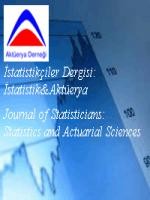Doğrudan Pazarlama Stratejilerinin Belirlenmesinde Veri Madenciliği Yöntemlerinin Kullanımı
Doğrudan pazarlama, ürünlerin olası müsterilerinin belirlenmesi ve belirlenen müsteri kitlesine bu ürünlerin
Anahtar Kelimeler:
Doğrudan pazarlama, Veri madenciliği, Sınıflandırma; Dengesizlik.
Use of Data Mining Methods in Determining Direct Marketing Strategies
Direct marketing is the process of identifying possible customers of products and promoting these products tothis specified customer mass. Recently, due to the fact that mass marketing campaigns targeting general publicare not successful, firms give more importance to direct marketing campaigns targeting a specific set ofcustomers. Direct marketing methods are more successful escpecially in banking sector where there is morepressure and competition according to other sectors. Data mining methods are used to increase the success ofdirect marketing campaigns by identifying the factors that effect these campaigns. Thus, these methods provideto direct available resorces and to create a reasonable and true set of potential customers. In this study, wefocus on how direct marketing campaigns can be directed in banking sector by using data mining methodssuch as decision trees, logistic regression, Bayesian networks and support vector machines. Also, we examineclass imbalance problem which frequently encountered in the analysis of this kind of data. As a result, SVMlinear, logistic regression and SVM RBF methods were the most successful methods according to the overallaccuracy metric. Moreover, according to the F measure, logistic regression, SVM RBF and CHAID, andaccording to the matthews correlation coefficient, SVM linear, logistic regression and CHAID methods havebeen identified as the most successful methods, respectively.
Keywords:
Direct marketing, Data mining, Classification; Imbalance,
___
- A. Agresti, Categorical Data Analysis, Wiley, 744p.
- I. Ben-Gal, 2007, Bayesian Networks, Encyclopedia of Statistics in Quality &Reliability,F. Ruggeri, F.Faltin, R. Kenett, R. (eds), Wiley & Sons.
- [3] S.G. Boettcher and C. Dethlefsen, 2003, Deal: A package for learning Bayesian networks, Journal of Statistical Software, 8(20), 1-40.
- D. Boswell, 2002, Introduction to Support Vector Machines, http://www.work.caltech.edu/~boswell/IntroToSVM.pdf.
- J. Cheng and R. Greiner, 2001, Learning Bayesian Belief Network Classifiers: Algorithm and System, Proceedings of the Fourteenth Canadian Conference on Artificial Intelligence (AI’2001).
- M.Ö. Dolgun, 2014, Veri Madenciliği Sınıflama Yöntemlerinin Basarılarının; Bağımlı Değisken Prevelansı, Örneklem Büyüklüğü ve Bağımsız Değiskenler Arası Đliski Yapısına Göre Karsılastırılması, Doktora Tezi, Sağlık Bilimleri Enstitüsü, Hacettepe Üniversitesi.
- D. Hand, H. Mannila, P. Smyth, 2001, Principles of Data Mining, The MIT Press, Cambridge, 546p.
- IBM, 2012, IBM DB2 version 9.5 manual, http://publib.boulder.ibm.com/infocenter/db2luw/v9r5/index.jsp?topic=%2Fcom.ibm.datatools.datamining.d oc%2Fc_decision_tree_calssification.html.
- F.V. Jensen, 2001, Bayesian Networks and Decision Graphs, Springer-Verlag, New York, 268p.
- D.T. Larose, 2004, Discovering Knowledge in Data: An Introduction to Data Mining, Wiley Interscience, New York, 222p.
- C.X. Ling and C. Li, 1998, Data mining for direct marketing: problems and solutions, Proceedings of KDD’98, 217-225.
- S. Moro, R.M:S: Laureano, P. Cortez, 2000, Using data mining for bank direct marketing: an application of the CRISP-DM methodology, Proceedings of the European Simulation and Modelling Conference (ESM’2011), Guimares, Portugal, October 2011, s.117-121.
- P.V. Putten, 1999, Data mining in direct ;marketing databases, Complexity and Management: A Collection of Essay, World Scientific.
- E. Simoudis , B. Livezey, R. Kerber, 1996, Integrating inductive and deductive reasoning for data mining. Advances in Knowledge Discovery and Data Mining. Fayyad, U.M., Piatetsky-Shapiro, G., Smyth, P., Uthurusamy,R. (eds), The MIT Press, Cambridge, s.353-374.
- P. Tan, M. Steinbach, V. Kumar, 2006, Introduction to Data Mining, Addison-Wesley, Boston, 769p.
- ISSN: 1308-0539
- Yayın Aralığı: Yılda 2 Sayı
- Başlangıç: 2008
- Yayıncı: Aktüerya Derneği
